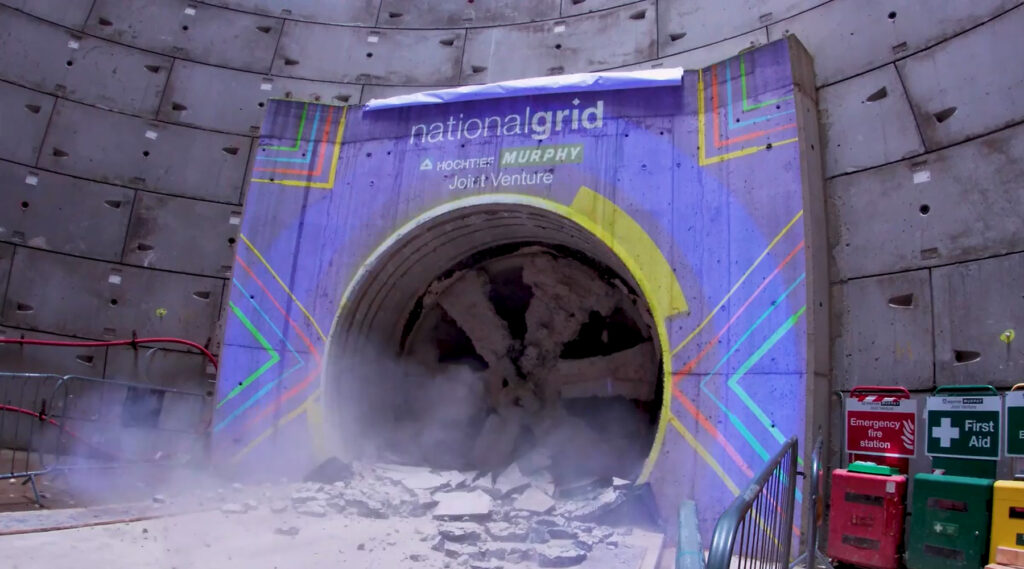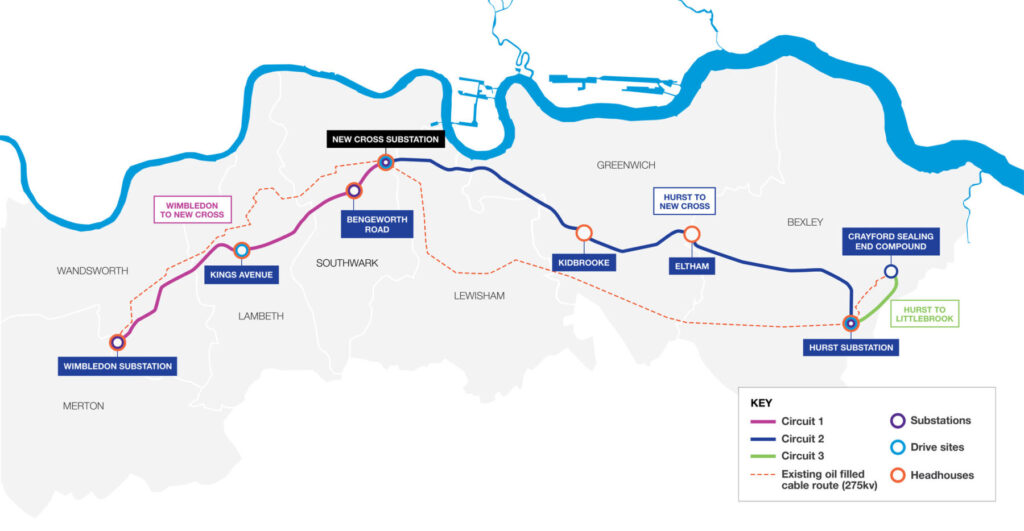The final section of a £1 billion tunnel has been completed under south London, when a tunnel boring machine (TBM) emerged into the Eltham substation.
The 11km long tunnel will eventually carry electricity cables and makes up part of the National Grid’s London Power Tunnels (LPT) project. When fully operational, it will replace a maze of cables running under London’s streets, which are wearing out and need replacing, but rather than digging up loads of roads, the National Grid has opted for a deep tunnel instead.
Construction of the tunnels began in March 2020, and tunnelling was carried out in three sections between existing National Grid substations:
- Wimbledon-New Cross (12km)
- New Cross-Hurst (18km)
- Hurst-Crayford (2.5km)
The last of the project’s TBMs, ‘Grace’, broke through last week, having been tunnelled over 11km eastwards from National Grid’s New Cross substation in Southwark.
Breakthroughs previously took place at Eltham in June 2022, Wimbledon in July 2022, Crayford in January 2023 and Kings Avenue in April 2023.
All 32.5km of the project’s underground route are now complete, with 200km worth of high voltage cable now being installed between substations at Wimbledon and Crayford.
Vertical shafts ranging between 9-15m in diameter and up to 55m in depth were constructed along the route, serving as waypoints for the TBMs, and helping project teams safely access the tunnels for maintenance now and when operational in the future (headhouses will be built to cover the shafts for safe future use).
The Hurst substation site recently saw a world record-breaking pour of cement-free concrete to fill the base of its 55 metre deep shaft following the two tunnel drives to Eltham and Crayford.
In another first for LPT, National Grid’s new Bengeworth Road substation on the tunnel route in Lambeth is being built free from greenhouse gas SF6 – the only one of its kind to date in Britain and part of National Grid’s ambition for its infrastructure to be SF6-free by 2050.
Alice Delahunty, president of National Grid Electricity Transmission, said: “Our London Power Tunnels project has achieved a lot since it kicked off in 2020, but the final tunnelling breakthrough at Eltham is a particularly remarkable moment.
“This complex engineering endeavour is now really taking shape, with completion of tunnelling now physically linking our sites across South London for the first time and meaning we can move on to the next chapter to progress our vital cabling work.
“The outstanding effort by our project teams and suppliers is strengthening London’s electricity network and making sure it safely, reliably and efficiently powers homes and businesses in the capital for years to come.”
The LPT project’s newly installed transmission infrastructure is due to be fully operational by 2026.









Why are you saying kilometres. We don’t use kilometres in this country.
I went to school in the 70s and early 80s. We were taught entirely using the ‘metric’ system. Anyone under about 60 years of age who can’t understand it is being willfully ignorant
The trouble is that you’re living in a very different country to the rest of us. You’re living in a country that doesn’t exist.
Science and engineering in “this country” use the metric system. That is why it is taught to our children in school
Because as per the first link that’s how National Grid are reporting the measurements and Ian is only repeating that info.
Canceled HS2 Birmingham to Manchester so strange. London really the best underground tube, Buses, Trains in UK. It’s horrible north England worst . Not fair .
This tunnel is for the electricity cables not trains!
So sad I feel for my manc friends
I live in Central Brighton
Apparently, basic grammar isn’t taught in ‘north England’ either.
Smashing job, they should hire these lot to complete HS2 on time, within budget and they might be able to add some environmental strategies in.
Unlike the wasted money that was HS2 managers not wanting projects to finish before they retire, workers going in signing in then going home clocking full pay.
Heard of the said people first hand not off a mate thst knows a mate. They saw government funding and ran with it. No investigation. On how they had to keep asking for billions every few years. Knowone should of got a bonus it wasn’t complete to budget timing, or even distance as now we’re not going north.
These guys on the other hand 👌
Nowhere in the article is the voltage to be used mentioned. The existing network is shown as 275kV. Any idea?
You could click through the first link to the National Grid website on the project
Quite good. Shame everyone else bitter about HS2 right now to appreciate this. I did feel bitter about the loss of Northern Powerhouse Rail, not anymore, just ashamed at our government again.
An achievement indeed.
I would like to know what happened to all the “spoil” generated; and what exactly is “cement free concrete”? (I hope that it will not cause problems in the future – such as we’re having with the “lightweight concrete” which was declared a wonder product some 50 years ago).